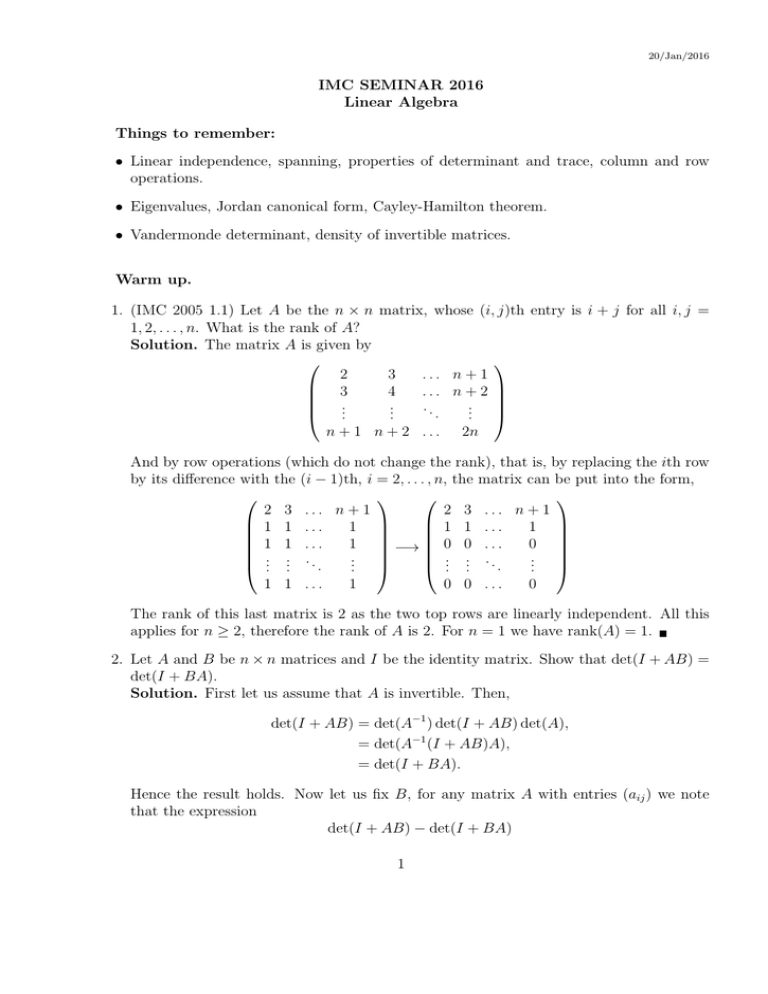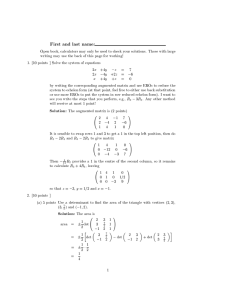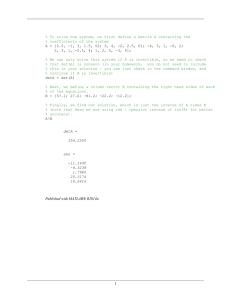IMC SEMINAR 2016 Linear Algebra Things to remember:
advertisement

20/Jan/2016 IMC SEMINAR 2016 Linear Algebra Things to remember: • Linear independence, spanning, properties of determinant and trace, column and row operations. • Eigenvalues, Jordan canonical form, Cayley-Hamilton theorem. • Vandermonde determinant, density of invertible matrices. Warm up. 1. (IMC 2005 1.1) Let A be the n × n matrix, whose (i, j)th entry is i + j for all i, j = 1, 2, . . . , n. What is the rank of A? Solution. The matrix A is given by 2 3 ... n + 1 3 4 ... n + 2 .. .. .. . . . . . . n + 1 n + 2 . . . 2n And by row operations (which do not change the rank), that is, by replacing the ith row by its difference with the (i − 1)th, i = 2, . . . , n, the matrix can be put into the form, 2 3 ... n + 1 2 3 ... n + 1 1 1 ... 1 1 ... 1 1 1 1 ... 1 0 −→ 0 0 . . . .. .. . . .. .. . . .. .. . . . . . . . . 1 1 ... 1 0 0 ... 0 The rank of this last matrix is 2 as the two top rows are linearly independent. All this applies for n ≥ 2, therefore the rank of A is 2. For n = 1 we have rank(A) = 1. 2. Let A and B be n × n matrices and I be the identity matrix. Show that det(I + AB) = det(I + BA). Solution. First let us assume that A is invertible. Then, det(I + AB) = det(A−1 ) det(I + AB) det(A), = det(A−1 (I + AB)A), = det(I + BA). Hence the result holds. Now let us fix B, for any matrix A with entries (aij ) we note that the expression det(I + AB) − det(I + BA) 1 2 is a polynomial on (aij ), therefore it is a continuous function from Rn to R. Moreover, 2 the set of invertible matrices form a dense subset in Rn and we have just proved that det(I + AB) − det(I + BA) vanishes on that subset. Thus, by continuity we conclude 2 that det(I + AB) − det(I + BA) = 0 for all A ∈ Rn . Finally since B was arbitrary, then the previous arguments applies also to all n × n matrices B. Homework. Bring your solutions next session on February 3rd. 1. Let A, B, C, D be n × n matrices such that AC = CA. Prove that A B det = det(AD − CB) C D 2. Let A, B ∈ M2×2 (R) such that A2 + B 2 = AB. Show that (AB − BA)2 = 0. 3. Does any rotation of a d-dimension sphere have a fixed point? 4. Let v0 be the zero vector in Rn and let v1 , v2 , . . . , vn+1 ∈ Rn be such that the Euclidean norm |vi − vj | is rational for every 0 ≤ i, j ≤ n + 1. Prove that v1 , . . . , vn+1 are linearly dependent over the rationals. Hint: Use the identity −2hvi , vj i = |vi − vj |2 − |vi |2 − |vj |2 . 2





